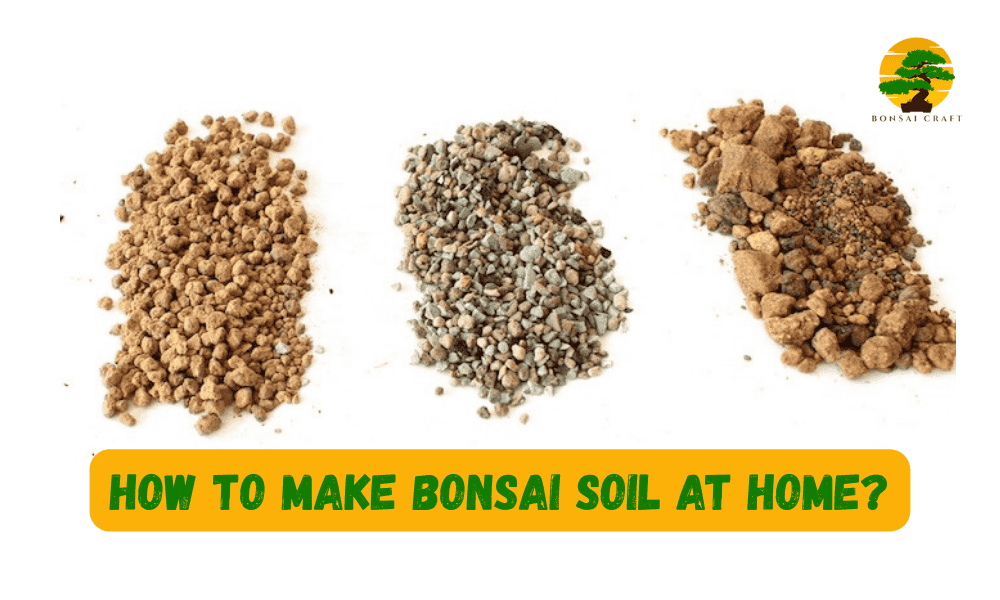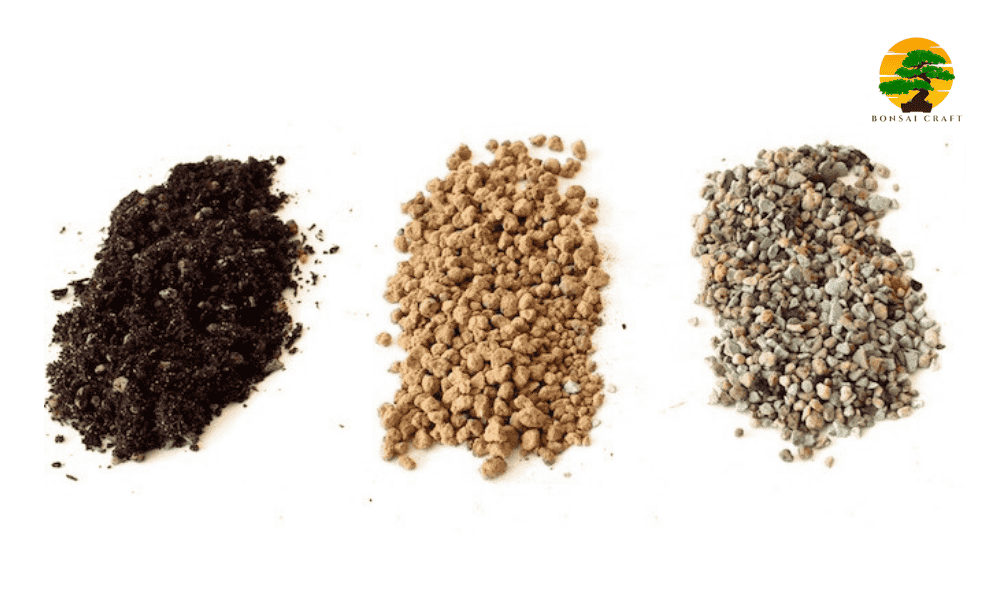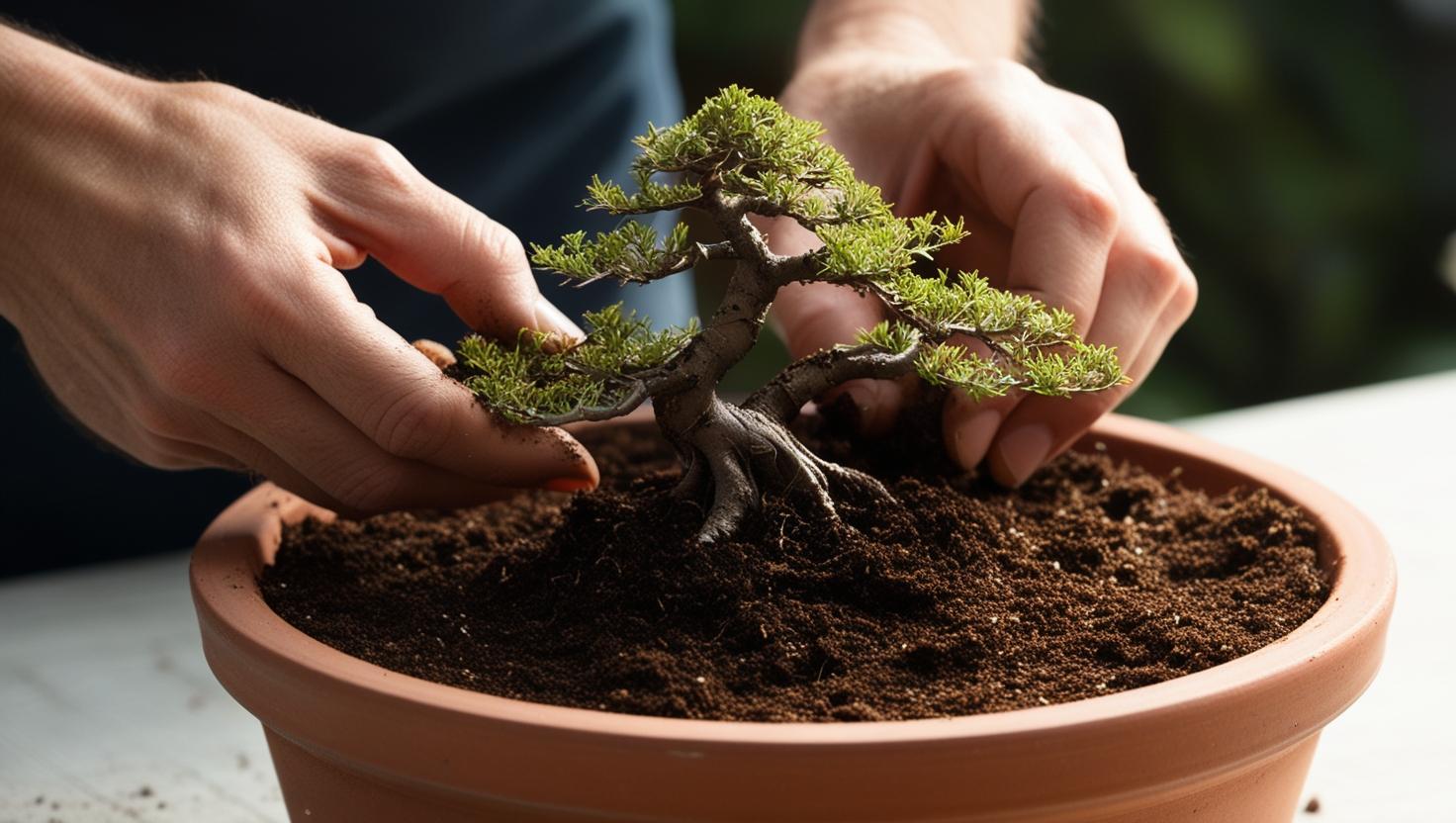
Both an art piece and a creation of nature, bonsai trees can only be described as captivating. These tiny trees, even though charming, will not flourish unless given a lot of attention. Besides water and sunlight, which are the lifeline of any plant, a bonsai tree needs the right soil to cultivate and thrive – more specifically, bonsai tree soil. Ensuring you have the right bonsai soil mix is the first step in making sure that your tree grows healthy, vibrant, and lives a long life.
No matter if you are new to bonsai or have been practicing it for years, one thing that is important to understand is that bonsai trees require a lot of care. Since they grow in pots, their roots have to deal with an enclosed space, unlike their counterparts in the wild. Thus, soil for bonsai trees becomes extremely important. In this article, we will discuss everything from the most crucial bonsai soil ingredients to making soil at home. Whether a beginner or an expert, you should know that bonsai tree soil makes growing a beautiful and healthy tree a lot easier.
What is Bonsai Soil
Bonsai soil is a specially formulated mix designed to meet the unique needs of bonsai trees. Unlike regular garden soil, which can compact and restrict root growth, bonsai soil is made up of a combination of porous, lightweight ingredients that help with drainage, aeration, and moisture retention. The key components of bonsai soil typically include inorganic materials like akadama, pumice, and lava rock, as well as organic materials like pine bark or compost.
This mix allows water to flow through the soil while also retaining just the right amount of moisture, preventing waterlogging or root rot. The soil composition ensures that the roots receive sufficient oxygen, which is vital for healthy root development and overall bonsai tree health. The exact bonsai soil mix varies depending on the type of tree being grown, with different species requiring different moisture levels, acidity, and drainage.
Why is Bonsai Soil Different from Regular Garden Soil?
Bonsai trees are essentially a scaled-down version of a tree, meaning they have a very specific set of requirements. Unlike garden trees which can be directly planted in the soil, bonsai trees are confined to pots, which means their root systems are limited to a smaller spatial area. Bonsai trees cannot make use of regular soil since it tends to be compact, restricting water flow and reducing the amount of air reaching the roots.
Bonsai soil is made up of loose and porous materials, enhancing proper drainage and aeration. The soil needs to retain moisture, but not so much that where it sits in water, which is crucial for bonsai trees. With bonsai soil, water is able to flow freely, keeping the bonsai’s roots hydrated at the appropriate levels.
The soil for a bonsai tree needs to have low weight while maintaining proper drainage. This ensures that the roots can grow and spread freely. Unlike regular soil, which can compact over time and suffocate the roots, bonsai tree soil enables healthy and strong root growth for the tree.

The Main Components of Bonsai Tree Soil
The Main Components of Bonsai Tree Soil
Mixing the appropriate bonsai soil ingredients requires careful consideration of how the tree will receive optimum care. A well-balanced bonsai soil mix recipe integrates inorganic materials (for drainage and aeration) with organic materials (for nutrient and moisture retention). Here’s a highlight of the common components that make up bonsai soil:
1. Akadama: The Bonsai Soil Base
Akadama is clay soil, which is moist but doesn’t soak, and drains adequately. Due to this, it’s one of the best components to consider when blending bonsai soil mix, especially in Japan. It’s also one of the most frequently used ingredients in bonsai soil.
The combination of water and drainage that bonsai trees need is unique, necessitating that they always sustain a certain balance, never dipping towards excessive or minimal water levels. The plant will not suffer from issues linked to bonsai overwatering, root drying, alongside underwater issues. Furthermore, when submerged under soil within a container, the roots are bound to rot.
Knowing how the components work synergistically, it is evident why akadama is effective alongside other elements. However, it should also be noted that it is very hard to get outside Japan and is very pricey as well.
The breakdown of Akadama soil’s structure over time is an added benefit because it assists in monitoring tree pruning. As akadama breaks down, its color changes, which serves as a cue to tell the user it could be time to change the soil mixture.
2. Pumice: Lightweight and Porous for Drainage
Pumice volcanic rock is exceptionally lightweight and porous. These attributes enable it to be a great ingredient in bonsai soil mixtures. The openings present in pumice contribute towards enhancing soil aeration, making oxygen available to the roots of the bonsai tree. Besides, pumice does hold some moisture, allowing the roots to remain damp without the danger of stagnant water.
These properties make pumice a key ingredient in soils for bonsai trees that prefer wet conditions with excellent drainage. The unique form of pumice helps to ensure that bonsai soils do not become too compacted, thus providing the tree roots with sufficient space to grow and spread.
3. Lava Rock: A Biophysical Aid for the Roots
Lava rock is yet another volcanic product that gives bonsai soil structure and aeration. It has very high porosity and superb drainage, but is particularly useful because of its coarse nature. Lava rock serves as an aid to root support and growth, which makes it all the more necessary for bonsai planted in shallow pots.
Moreover, bonsai trees in smaller-sized containers placed in shallow pots benefit from the coarse nature of volcanic rock because it aids in the bearing of roots with soil. Besides, like pumice, it retains moisture, but not too much, thereby maintaining proper drainage while still providing hydration.
4. Organic Materials: Important Nutrients Required for Bonsai Tree Growth
Alongside the artificial constituents, bonsai soil also contains organic materials such as pine bark or compost. These elements are critical in supplying the tree with nutrients necessary for its growth. The use of pine bark is due to its gradual decay, which releases nutrients over an extended period of time.
Compost is an organic-rich item that is packed with nutrients and aids in moisture retention in soil. While compost improves soil organic matter, it’s imperative not to exceed its application since excess organics can lead to increased moisture in the soil and may cause root rot.
5. Gravel: Ensuring Excellent Drainage
Gravel bonsai soil helps in keeping the drainage of the plant healthy. When added at the bottom of the pot, it acts as a reservoir for excess water. Also, gravel prevents the soil from falling into the root zone and creating a negative environment for the tree.
Certain bonsai soil blends also include compost in the mix, which is done in order to improve drainage. This is crucial for fast-draining soil required for some other trees like junipers or pines.
The Role of Soil in Water Retention and Drainage
Moisture retention and drainage are essential in the cultivation of bonsai trees. If too much water is held in the mix, then the seeds are likely to drown. Too little moisture might dry out the seeds. The secret is to ensure that water is retained, but excessive water is drained out.
Different species of bonsai trees have differing needs when it comes to soil. For instance:
- Tropical bonsai trees such as Ficus or Jade prefer soils with better moisture retention due to their high water needs.
- Pine or juniper bonsai trees, on the other hand, require fast-draining juniper bonsai soil to prevent excess moisture and root rot.
Customizing Your Bonsai Soil Mix
Making the perfect bonsai plant soil mixture requires understanding your bonsai species and environmental conditions. Naturally, how to make bonsai soil depends on species, climate, and watering schedule. A commonly recommended mix for deciduous trees includes 50% akadama, 25% pumice, and 25% lava rock. For coniferous trees, a 30-30-30 mix of akadama, pumice, and lava rock is often used.
Ready-Made vs. DIY Bonsai Soil Mix
While some people choose to source their materials for how to make bonsai soil at home, most choose pre-made soil for bonsai plant mixes that are available mostly online or at particular gardening shops. These mixes are pre-made, and this is very helpful for beginners since they are made with specific trees and conditions in mind.
Bonsai Soil Mixes for Individual Tree Species
Typically, bonsai soil should be prepared with more than one specific bonsai tree in consideration. Here are different tree species and how their soil needs should be tweaked to use the same bonsai soil mix:
1. Ficus Bonsai Soil Mix
Ficus Bonsai trees flourish in moderately tropical settings, which is one of the reasons why they like their soil to remain slightly moist. For a balance between moisture retention and drainage, you may consider using a Ficus bonsai soil mix recipe made of 40% akadama, 30% pumice, and balanced organic matter such as fibrous peat or pine bark. This mix will enable your bonsai tree to withstand moisture, thereby allowing excellent drainage to sustain the tree against waterlogging.
2. Juniper Bonsai Soil Mix
Juniper bonsai trees are coniferous, which means they need soil that is quick to drain so that roots do not rot. Juniper bonsai requires soil mix with 60% of Akadama, 20% of Pumice, and 20% of lava rock, which is a highly suitable ratio for Juniper bonsai. With this ratio, it is assured that water drains fast, preventing the retention of excess moisture in the soil.
3. Pine Bonsai Soil Mix
Pine trees prefer slightly acidic soil and are very particular about moisture levels. Hence, a proper mix for pine bonsai trees would be 40% of Akadama, 30% of Pumice, and 30% of lava rock. It ensures the soil is acidic and also maintains the required dry conditions around the roots of the tree.
4. Azalea Bonsai Soil Mix
Azaleas prefer slightly acidic and well-draining soil. A good mix for azalea bonsai trees is 50% lava rock, 30% akadama, and 20% pine bark. This mix ensures proper drainage as well as an acidity level favorable for azaleas.
How to Make Bonsai Soil at Home
Creating your own bonsai soil is simple and fun. By customizing the blend, you’ll be able to cater it to the needs of your tree. Follow this simple guide to prepare bonsai tree soil:
- Choose Your Ingredients: Opt for akadama, pumice, and lava rock along with organic additions like pine bark or compost. The exact amounts will depend on the type of bonsai you are growing.
- Mix the Ingredients: Combine your selected ingredients in the appropriate bonsai soil mix ratios for your tree species. For example, a 50% akadama, 25% pumice, and 25% lava rock mix works well for many deciduous trees.
- Test the Drainage: After mixing, ensure proper drainage by watering the soil thoroughly. If the blend quickly drains while still retaining some moisture, then your mix is good to go.
Preparing a custom bonsai soil recipe encourages exploration for the best possible mix suited for your tree. Additionally, it allows for finer quality control of the soil.

Potting Your Bonsai with the Right Soil
After gathering the correct ingredients for the bonsai soil mix, it is time to pot your customized bonsai tree. A proper potting procedure is required so that the roots have sufficient space, as well as proper drainage. In doing so, keep these directions in mind:
- Preparing the Bonsai Pot: Ensure that the pot you are utilizing has drainage holes present. In case the holes are too big, cover them with mesh to prevent soil from escaping.
- Start with Adding Gravel: Begin by placing gravel on the very bottom of the pot. This will prevent water from stagnating around the roots while also aiding with drainage.
- Positioning of Roots: Confirm that your tree is placed directly in the center of the pot and carefully spread the roots to give them adequate space to expand.
- Filling with Bonsai Soil: Proceed by adding the bonsai soil mix recipe on top of the roots. Doing so maintains an even level of soil around the roots.
- Ensure Proper Watering: It is crucial that after potting, you water the tree. Watering ensures that the soil settles, while the roots receive sufficient hydration.
Conclusion
Carefully formulating the bonsai soil mix is crucial for your tree’s health and longevity. By selecting the right ingredients like akadama, pumice, lava rock, and organic materials such as pine bark or compost, you create an optimal environment for the roots to thrive. These elements work together to maintain proper drainage, aeration, and moisture retention, which are essential for healthy root development.
The right bonsai soil ensures that the tree receives the necessary oxygen, nutrients, and water, which is vital for its growth. Adjusting the bonsai soil mix ratios based on the species of tree will help it flourish in its confined space. Regularly replacing the soil as it breaks down keeps the environment fresh, ensuring continued growth and vitality.
Ultimately, the quality and formulation of your bonsai soil mix are fundamental to the success of your bonsai tree. By choosing the right mix, you’ll support both the health and aesthetic beauty of your tree for years to come.
Frequently Asked Questions (FAQs)
What is bonsai soil, and why is it different from regular soil?
Bonsai soil is specially formulated for bonsai trees to ensure proper drainage, aeration, and moisture retention. Regular soil doesn’t meet the needs of bonsai trees because it can become compact, restricting water flow and oxygen to the roots.
How to make bonsai soil at home?
To make bonsai soil at home, mix akadama, pumice, lava rock, and organic materials like pine bark or compost. The bonsai plants soil mix ratios depend on the specific tree species.
How often should bonsai soil be replaced?
Bonsai soil should typically be replaced every 2-3 years, or when it breaks down and loses its ability to drain properly, and its structure breaks down.
Which soil is most suitable for ficus bonsai trees?
The best mix for ficus bonsai trees is 40% akadama, 30% pumice, and 30% organic material like fibrous peat or pine bark.
What steps should I follow to prepare the soil for my bonsai tree?
To prepare bonsai soil, mix the appropriate ingredients for your tree’s needs, or use pre-made mixes tailored for specific types of bonsai trees.
